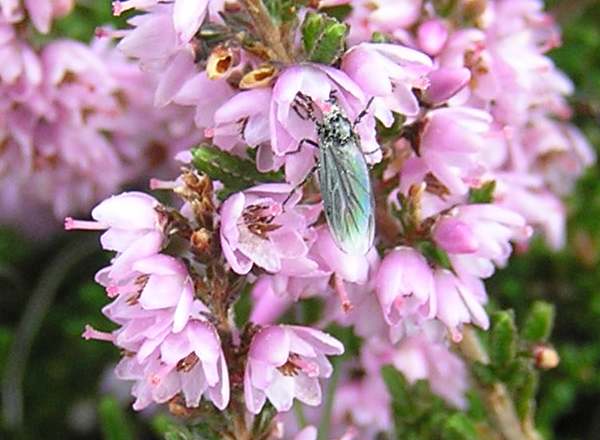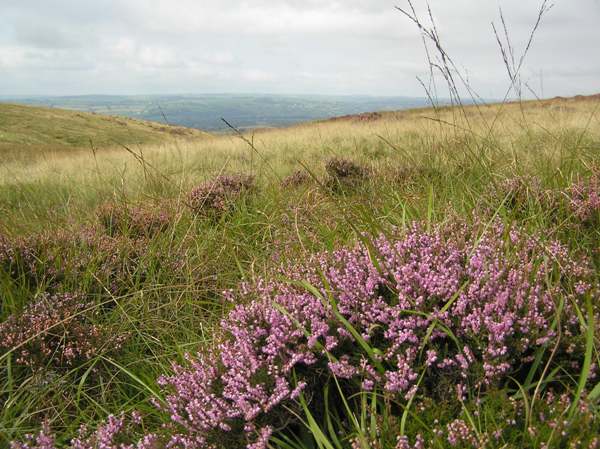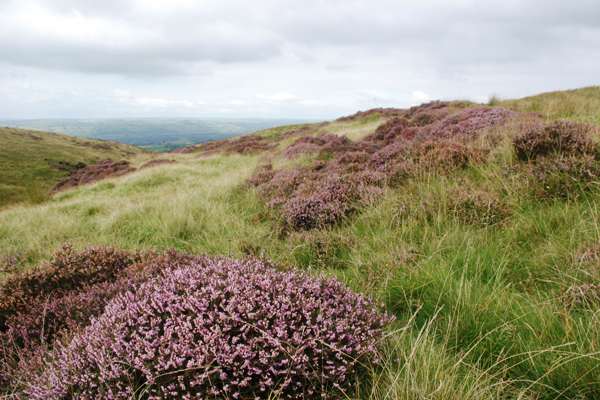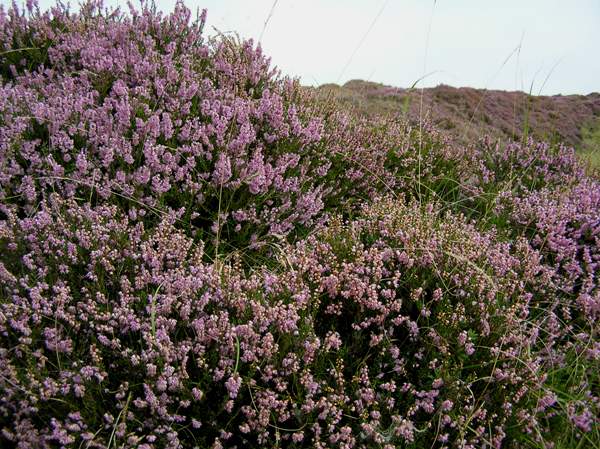Calluna vulgaris - Common Heather or Ling
Phylum: Magnoliophyta - Class: Equisetopsida - Order: Ericales - Family: Ericaceae
When heather is in full bloom it turns moors and mountainsides a lovely mauve colour, and in some places the combination of heather and gorse creates a colourful (and often impenetrable) patchwork on hillsides and coastal cliffs.
Usually growing to about 50cm but occasionally twice that height, the flowers spikes are a lovely pale pink-to-mauve or sometimes white (known as 'lucky white heather'), and small oblong opposite scale-leaves occur along the stems.

With sepal-like bracts at the flower bases and a calyx of four pink-purple sepals, the corolla comprises four triangular lobes.
Distribution
Calluna vulgaris is the dominant heathland plant in many parts of Britain and Ireland, where it can be found on almost any heath or moorland except for very wet areas, where Erica tetralix is more at home.
In mainland Europe, from northern Scandinavia right down to the Mediterranean and the Iberian Peninsula, Common Heather is indeed common in many non-calcareous regions; it occurs also in parts of Asia.

This is the only known Calluna species, and it is easily distinguished from other commonly-encountered kinds of heathers.
Habitat and Blooming Times
Heather thrives in low-nutrient acidic soils, and so moorland an mountain slopes where thin peaty soil lies upon granite are places where you can expect Heather to flourish. Calluna vulgaris can also be found in mature conifer woodlands, often along with Erica tetralix (Cross-leaved Heath) and Erica cinerea (Bell Heather), particularly where selective felling has created small clearings or a patchwork of light and shade. Depending on longitude and the degree of sunshine exposure, Common Heather (also referred to as Scots Heather or sometimes Scotch Heather) blooms from July until September and is usually at its best in late August, brightening up the countryside when most of the other wildflowers have died back.

Uses
Traditionally, besoms are made by tying bunches of heather to a handle to make a coarse broom for sweeping floors; they were standard household items in the days of 'dirt floors' and are still pictured as 'witches' brooms'. Other past uses of Heather was in the dyeing of wood and the tanning on leather, but perhaps its most enduring value is as the source of 'heather honey'. During late summer hives of honey bees are transported to heather moorland, where the bees gather nectar from the Heather flowers and produce a very special and much valued kind of honey.
Sheep and deer eat the growing tips of Heather - as do Red Grouse, which also feed on the seeds in winter. Calluna vulgaris is also an important source of food for several kinds of butterflies.
Above: Coastal heathland at South Stack, in North Wales, where Calluna vulgaris interspersed with gorse and various other heathland shrubs creates a colourful landscape in high summer.
Etymology
The genus name Calluna is derived from the Greek verb kalluno, which means 'to sweep' - a reference to the tradition of using Common Heather/Ling to make brooms and brushes. The specific epithet vulgaris means common.
The Calluna vulgaris shown on this page was photographed in Wales in August.
Sue Parker's latest ebook is a revised and enlarged second edition of the acclaimed Wildflowers in the Algarve - an introductory guide. Full details here...
Buy it for just £3.95 on Amazon...
Please Help Us: If you have found this information interesting and useful, please consider helping to keep First Nature online by making a small donation towards the web hosting and internet costs.
Any donations over and above the essential running costs will help support the conservation work of Plantlife, the Rivers Trust and charitable botanic gardens - as do author royalties and publisher proceeds from books by Pat and Sue.




